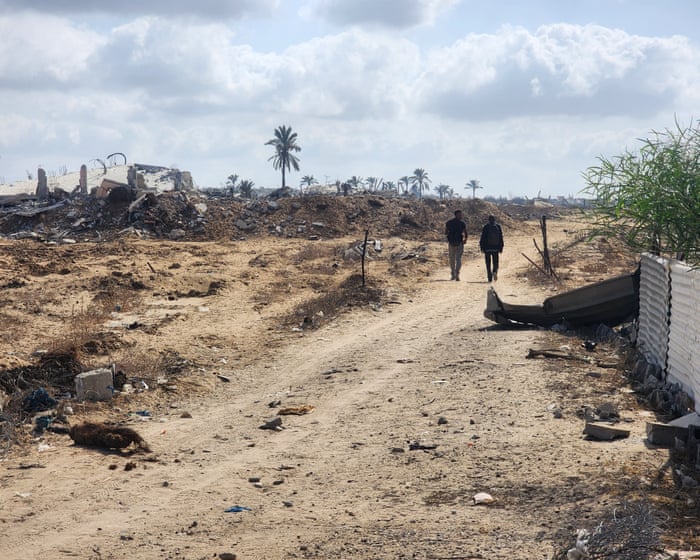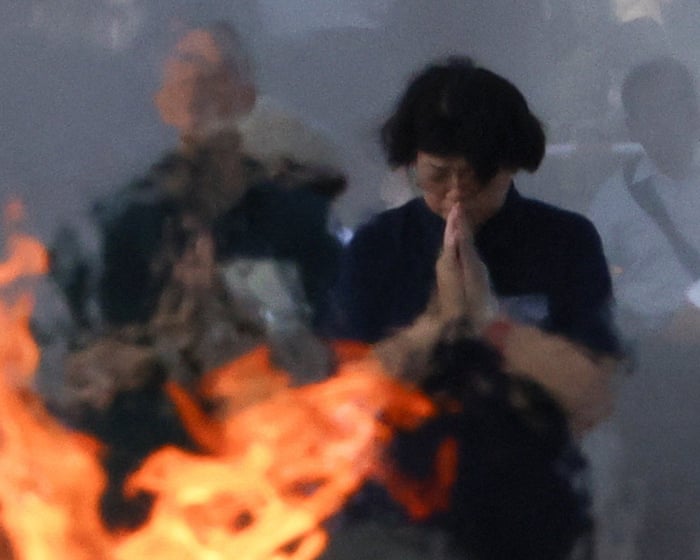A temporary yellow line marking Gaza’s ceasefire is becoming more physically defined as the fragile truce shows signs of stalling, with potentially significant consequences for Palestine’s future.
Israeli Defense Forces (IDF) have begun placing yellow concrete markers every 200 meters to outline the area that remains under Israeli control during the initial phase of the ceasefire. This line effectively splits Gaza in half.
In the western section, Hamas is working to regain control in the vacuum left by Israel’s partial withdrawal, conducting public executions of rival militia or gang members it claims are supported by Israel.
In the other half, which includes the eastern strip and the northern and southern borders, the IDF has been strengthening numerous military outposts and firing at anyone approaching the line, whether it is marked with yellow blocks or not.
Mohammad Khaled Abu al-Hussain, a 31-year-old father of five, shared his experience: “In our area, the yellow lines aren’t clearly visible. We don’t know where they begin or end. I think they’re more defined elsewhere, but here, nothing is clear.” His family’s home is in al-Qarara, north of Khan Younis and just east of the yellow line, within the IDF-controlled zone.
“As soon as we get near our homes, bullets start flying from all directions, and sometimes small drones hover above us, watching our every move,” he said. “Yesterday, I was with my friend when we suddenly came under heavy gunfire. We threw ourselves to the ground and stayed there until it stopped. I couldn’t reach my house.”
“It feels like the war hasn’t really ended for me. What’s the point of a ceasefire if I still can’t go home?” he added. “It breaks my heart to see others returning to their houses while I’m stuck between hope and fear. But what worries me most is the possibility that this line might become permanent, and no decision will ever allow us to return.”
The policy of shooting anyone near the line, ordered by Israeli Defense Minister Israel Katz, followed an attack on October 19 in Rafah that killed two Israeli soldiers.
Two weeks into the ceasefire, more than 20 Palestinians are still being killed daily on average, many near the yellow line. As a result, very few displaced people are returning to the area under Israeli control.
Political obstacles remain significant for moving to the second phase of the ceasefire, which would involve disarming Hamas and replacing it with a multinational stabilization force, along with an IDF withdrawal from the yellow line to positions closer to the Gaza border. The right wing of Prime Minister Benjamin Netanyahu’s coalition strongly opposes further withdrawal and the internationalization of control over Gaza.
Amid the stalemate, the yellow line is increasingly taking on a more permanent appearance and is being referred to in Israeli media as a “new border.”
In Yedioth Ahronoth newspaper, military correspondent Yoav Zitun predicted that the yellow line could develop into “a high and sophisticated barrier that will shrink the Gaza Strip, enlarge the western Negev, and allow for Israeli settlements to be built there.”
Jeremy Konyndyk, president of Refugees International and a former U.S. aid official, commented, “It looks like a de facto creeping annexation of Gaza.”
A screen grab from a video shows an Israeli vehicle moving yellow blocks to mark the dividing line in Gaza.
The U.S.-brokered ceasefire took effect on October 10.However, the IDF’s withdrawal to the yellow line would still leave it occupying 53% of the Gaza Strip. A BBC satellite analysis of the new yellow markers indicated they had been placed several hundred meters beyond the proposed line, suggesting a further significant land seizure.
An IDF spokesperson declined to comment on the BBC report. An earlier statement from the IDF mentioned that work had begun to mark the yellow line with a “3.5-meter-high concrete barrier topped with a yellow pole,” intended to “establish tactical clarity on the ground.”
What is emerging is an increasingly stark division of Gaza, with most of the surviving 2.1 million residents squeezed into half the territory, surrounded by the devastation left after two years of Israeli bombardment.
“The yellow line, as we understand it, lies about 1km past Salah al-Din Street,” said Ayman Abu Mandeel, referring to the main road running north-south through the center of Gaza.
Abu Mandeel, 58, has nine children and the remains of a house in eastern al-Qarara, but he holds little hope of returning anytime soon. “The Israeli army has set up cranes, watchtowers, and tanks there. They watch every move and shoot at anyone who approaches.”
“We haven’t seen the yellow markers ourselves because anyone trying to reach those areas is immediately targeted,” he added. “The drones don’t hesitate to fire at anyone moving toward them, as if approaching our own land has become a crime.”
The ongoing division and violence stem from the ambiguity of the truce. The “Trump peace plan” outlined 20 principles and objectives but lacked a clear sequence or explanation of how one goal would lead to the next.
“It is incredibly vague,” said Rohan Talbot, director of advocacy and communications for the charity Medical Aid for Palestinians. “Now we’re at a point where many parties—including the Israeli government, the Americans, the international community, and humanitarian groups—are all competing to interpret and shape what happens next.”
“One lesson we’ve learned from decades of difficult experience is that anything temporary in occupied Palestinian territory quickly becomes permanent.”
Meanwhile, at least half of Gaza’s population remains unable to return home or even consider rebuilding. The hopes raised by the ceasefire are rapidly diminishing.
“Every time we try to get closer to home, we see new destruction, new bombings, and military vehicles advancing. The shelling from artillery, tanks, and drones hasn’t stopped; it feels like the war never ended,” said Salah Abu Salah from Abasan al-Kabira in east Khan Younis, which is now on the “wrong” side of the yellow line.
“I can’t help but worry that the army plans to set new borders that we’ll never be allowed to cross again.”
Frequently Asked Questions
Of course Here is a list of FAQs about the concern that the temporary ceasefire line in Gaza could solidify into a permanent border with clear and direct answers
Basic Understanding Definitions
1 What is the temporary ceasefire line in Gaza
This refers to the boundary line established after a period of fighting where hostilities have temporarily stopped Its often based on the front lines where the opposing forces were positioned when the ceasefire began
2 What does it mean for a line to solidify into a permanent border
It means that a temporary informal line created by a ceasefire could over time become accepted by the international community and the involved parties as the official legally recognized international border of a state
3 Why is this a concern now
There is a fear that without a formal peace agreement the current temporary situation could become the default lasting reality This could happen because rebuilding and returning to prewar lines becomes too difficult or because political momentum for a final peace deal is lost
Implications Consequences
4 What are the main arguments against this happening
Many argue that a border imposed by conflict rather than negotiation would not lead to a lasting peace It could be seen as rewarding military action leave key issues unresolved and would likely not be accepted by the Palestinian people as a legitimate state border
5 What are the potential benefits if it did become a formal border
Some might argue that having a clear defined bordereven one created this waycould provide a starting point for stability It could reduce immediate friction and create a foundation to build upon for future relations similar to how other conflict zones have stabilized
6 What problems could this create for a future Palestinian state
A border solidified from a ceasefire line could be highly unfavorable potentially leaving a future Palestinian state with a noncontiguous territory limited access to resources and without control over its airspace or borders making it economically unviable
7 How would this affect the prospect of a twostate solution
It could severely damage it A twostate solution is meant to be negotiated with agreedupon borders that are viable for both sides A unilaterally solidified border would likely be seen as illegitimate and could kill the political will needed to negotiate a final comprehensive agreement




